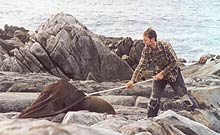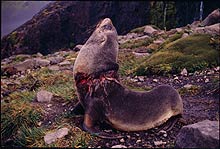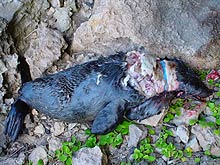Ghost
Fishing - Reducing the impact of fishing
on non target species
by Brad Page La Trobe
University PhD student |
|
The
issues
In recent years, Australian governments
and fishing industry associations
have developed guiding principles
aimed at reducing the impact of fishing
on non-target species and the benthos
and increasing community awareness
of their efforts.
To
determine whether they reduced seal
entanglement in lost fishing gear
and other marine debris, we analysed
Australian sea lion and New Zealand
fur seal entanglement data collected
from Kangaroo Island, South Australia.
Contrary to our expectations, we found
that entanglement rates did not decrease
in recent years. The Australian sea
lion entanglement rate (1.3% in 2002)
and the New Zealand fur seal entanglement
rate (0.9% in 2002) are the third
and fourth highest reported for any
seal species.
|

Catching
the seals to release the nets and tape.
Photograph courtesy Jen Palmer |
| |
|
|

Entanglement
photograph courtesy Magaly Chambellant
|
Australian sea lions were most frequently entangled in monofilament gillnet that most likely originated from the shark fishery, which operates in the region where sea lions forage - south and east of Kangaroo Island. In contrast, New Zealand fur seals were most commonly entangled in loops of packing tape and trawl net fragments suspected to be from regional rock lobster and trawl fisheries.
Based on recent entanglement studies, we estimate that 1,478 seals die from entanglement each year in Australia. We discussed remedies such as education programs and government incentives that may reduce entanglements. |
|
The
Research
For a seal in the middle of the ocean,
a loop made of plastic or rope is something
to throw around to help pass the time,
but the seal doesn't realise that such
toys can kill. The seal doesn't see
it coming and doesn't understand where
the loop disappears to, but as the seal
swims off the loop of rubbish starts
constricting around its neck. La Trobe
University PhD student Brad Page, who
is researching the effect of lost fishing
gear on New Zealand fur seals and Australian
sea lions, estimates that this happens
to about 1500 seals in southern Australia
each year.
Although
most of the debris we find entangling
seals is from the fishing industry,
we have removed several plastic bags,
a string of burst balloons and a few
rubber o-rings. If a seal is lucky
it has picked up a loop biodegradable
packing strap, which starts off around
fishers bait boxes, and the seal may
get a second chance if the loop rots
and breaks off its neck.
Unable
to catch fish thanks to the added
drag caused by the rubbish, the rubbish
also cuts a painful, gaping wound
that will fester and never heal. Left
alone in this condition the seal would
die within a few weeks and the piece
of plastic would eventually blow around
the colony and possibly catch another
seal.
While
the death of some seals from the accidental
loss of fishing gear is unavoidable,
some fishers do not understand that
lost fishing gear causes slow and
painful deaths to many marine animals.
The rescue of entangled seals by La
Trobe University researchers appears
most unwelcome as the suffering seals
dash for the water, only to be caught
like a vagrant dog in a dog-catcher's
net. The seals bite the net as the
La Trobe University researchers cut
the loop and tear the rubbish out
of the seals' flesh.
Brad
Page believes that so many Australian
sea lions die in this way that lost
fishing gear may be one of the major
factors keeping the sea lion population
stable at around 11500 for the last
15 years - a period when neighbouring
fur seal populations have been rapidly
increasing.
Most
of Brad's PhD focuses on seal-fishery
competition for the fish and squid
that we enjoy eating as much as the
seals. To assess levels of competition
between seals and fishers Brad has
been tracking seals to determine where
they feed and sieving seal scats to
find out what they eat. Amazingly,
New Zealand fur seals don't take many
fish that we find on our dinner plates.
Seals prefer a small fish called red
bait as well as squid and little penguins.
One seal had even eaten a 2kg Australasian
gannet!
My
interest in individual seal welfare
developed as a time-consuming passion
from working on seals in remote, untouched
wilderness reserves such as Heard,
Macquarie and Kangaroo Island, where
catching entangled seals can be a
weekly event.
|
| |
|
|
Over
the last few years the Commonwealth
Government and fishing industry associations
have developed guidelines for commercial
fishers, to help reduce this unaccounted
fishing mortality and the impact of
fishing on the rest of the marine
environment. Unfortunately these guidelines
have not reduced the proportion of
seals getting entangled in rubbish
each year, with numbers of entangled
seals actually rising in recent years,
from one in three hundred to more
than one in a hundred seals at colonies
on Kangaroo Island in South Australia.
The
La Trobe University researchers have
an exciting, exacting and occasionally
dangerous job in trying to save some
of these seals. Sprinting across jagged
rocks after injured seals that are
terrified because they think they're
going to be killed has resulted in
some serious injuries to the would
be captors, but they manage to catch
two in every three that they find.
|

Dumped
or discarded fishing gear proved fatal.
Photograph courtesy Brad Page. |
| |
|
After
receiving funding from 11 interested organisations,
Brad produced and disseminated, between March
and June 2003, 10000 brochures to commercial
fishers operating from Sydney to Broome, advising
them of the hazards of the fishing gear they
lose in the sea. The fishing industry associations,
State Government Fishery managers and most
commercial fishers have been very encouraging
of the project as they understand its only
a few rogue fishers that are dumping rubbish
at sea. We are still trying to get the pamphlets
to some fishers in the Commonwealth sector.
One rock lobster fisher even called me and
asked for some posters to display in the pub
on Kangaroo Island.
The
La Trobe University study, which will be
published in the Marine Pollution Bulletin,
recommends that governments provide incentives
to bait packing companies to use biodegradable
packing straps on bait boxes and to fast-track
research to determine how so much monofilament
netting is ending up around the necks of
Australian sea lions and quantify its effect
on the sea lion population. For example,
the removal of packing tape from the fishing
industry will prevent entanglement of more
than 300 seals in Australia each year.
Free
posters and pamphlets can be obtained from
Brad by email: B.Page@zoo.latrobe.edu.au
|
